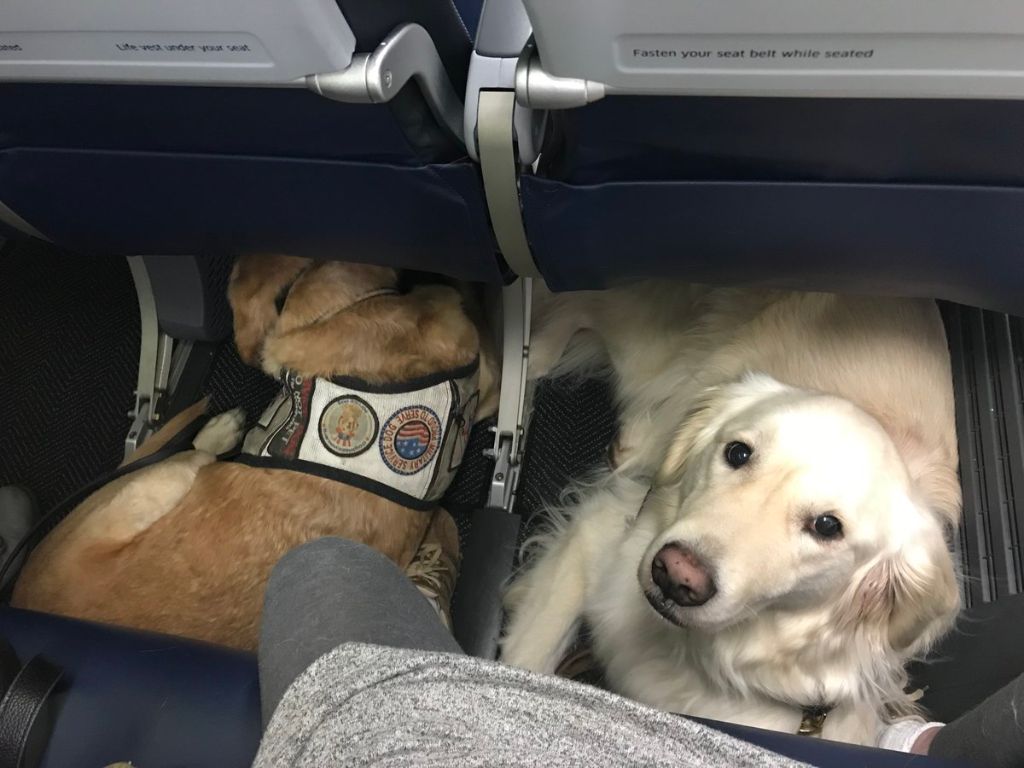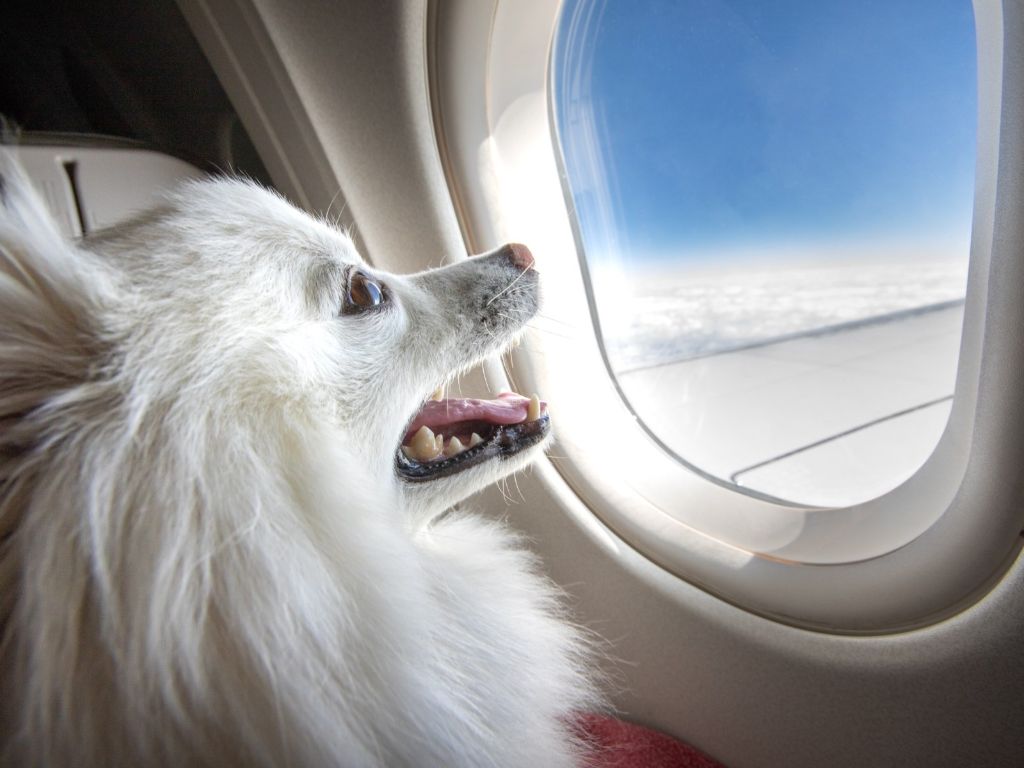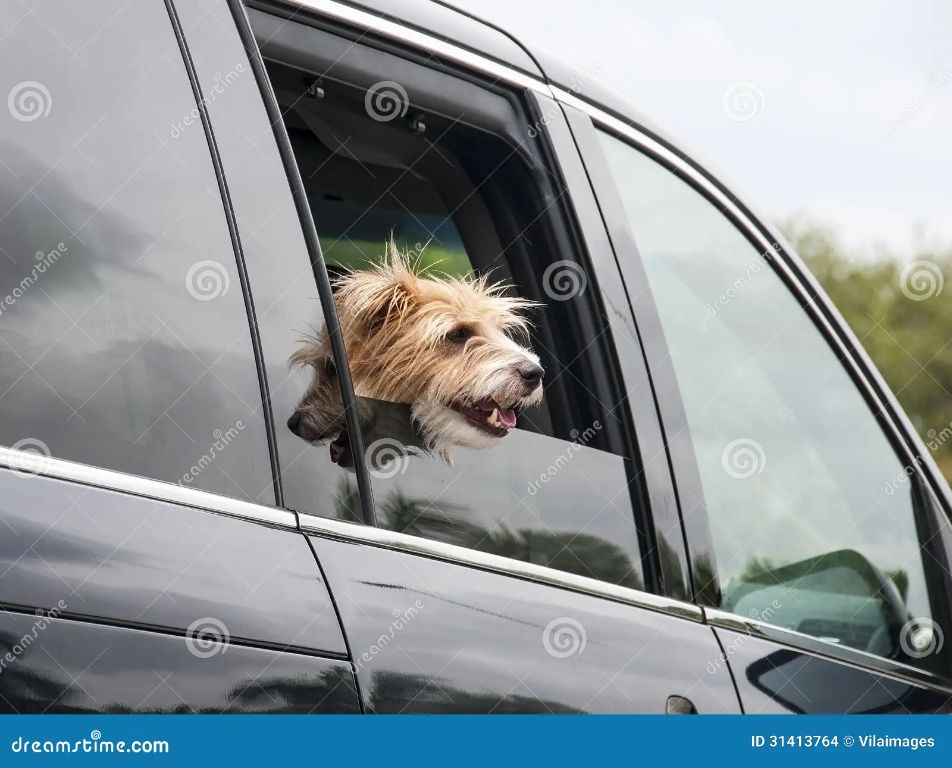Introduction
Bringing your dog with you on an airplane flight has become an increasingly popular option for pet owners. While air travel can be stressful for animals, many major airlines now allow dogs to fly in the cabin or cargo hold if the proper procedures are followed. This allows pet owners to avoid leaving their dogs home alone or having to utilize other transportation methods.
When bringing a dog on an airplane, pet owners will need to consider the airline’s policies, any costs involved, necessary preparations like obtaining a health certificate from a vet, proper equipment like a carrier, and steps to take on the day of travel. With some planning and preparation, both owner and dog can have as comfortable a flight experience as possible.
Rules and Regulations
When flying with a dog, it is important to understand the rules and regulations set by different airlines. Each airline has their own pet policy that dictates the size of carrier allowed, where the pet can be placed, applicable fees, and dog breed restrictions. According to BringFido, airlines like Delta and United have more flexible policies that allow dogs to travel in the cabin with their owner if they are in a compliant carrier. Other airlines like American and Frontier are more restrictive with rules about pet transportation.
Some key regulations to be aware of when reviewing airline pet policies:
- Size of dog crate – Most airlines require soft-sided carriers no larger than 18″ x 11″ x 11″ that comfortably fit under the seat in front of you.
- Pet fees – Expect to pay a pet fee around $125 each way to bring your dog in the cabin.
- Breed restrictions – Some airlines prohibit snub-nosed dog breeds due to health risks.
- Number of pets allowed – Typically only 1-2 pets are permitted in the cabin per passenger.
- Pet documentation – Proof of vaccination may be required.

According to Chewy, over 2 million pets are transported by airlines in the U.S. each year. Reviewing the detailed airline policies in advance is crucial to avoid issues and ensure your dog is comfortable when flying.
Booking Dog Seats
Only a few airlines allow passengers to purchase a separate seat for their dog. According to NerdWallet, JetBlue and semiprivate carrier JSX are the only major airlines in the US that permit dogs to have their own seats, though there are restrictions (Source 1).
To reserve a seat for your dog on JetBlue, you must contact the airline’s Special Assistance Desk. All dogs traveling in seats must be at least 4 months old and must be able to sit upright without blocking the aisle. Owners are responsible for providing a safety restraint device that attaches the dog to the seat (Source 2).
JSX allows small dogs under 50 lbs to sit in their own seats, but advises calling customer service to purchase. The dog must be able to sit on the floor or owner’s lap during taxi, takeoff, and landing. JSX does not allow in-cabin pets on flights over 5 hours (Source 3).
Seat Options
When purchasing a seat on a plane for your dog, there are typically two seat options available depending on the airline and aircraft:
In-cabin
Some airlines allow small dogs under a certain weight limit (usually around 15-20 pounds) to fly in-cabin in an approved carrier that fits under the seat in front of you. This allows your dog to stay close by your feet during the flight. The in-cabin option is less expensive but has more size restrictions.
Regular airplane seat
Larger dogs that exceed the in-cabin size and weight restrictions can purchase a regular seat next to their owner. They would need to be secured to the seat by a carrier or harness system that attaches to the seat belt. This option provides more space but is more expensive than an in-cabin ticket.
When booking, be sure to check with the airline on their specific policies for pets in seats and any size or breed restrictions. The type of aircraft can also impact the seats available for dogs.
Cost
The cost to book a seat for your dog on an airplane can vary greatly depending on the airline, route, and other factors. Most major U.S. airlines charge a pet fee ranging from $100-200 each way for domestic flights, according to Progressive (https://www.progressive.com/lifelanes/turning-points/costs-of-flying-with-pets/). For international flights, fees are generally higher. Pet Travel reports that on United flights to Europe, fees range from $400-1,000 each way (https://www.pettravel.com/0001216.cfm).
On United Airlines’ website, they list a flat $125 pet fee each way for domestic flights and a $275 pet fee each way for most international flights in economy seating (https://www.united.com/en/us/fly/travel/traveling-with-pets.html). However, they note fees may be higher depending on your origin and destination. So it’s important to check with your specific airline for current rates.

The size of your dog can also impact the cost. Larger dogs that need to fly in cargo vs. the cabin will have higher fees, often $300 or more each way.
Considerations
There are several important things to think about when flying with a dog according to Everything to Know About Flying with a Dog. First, assess if your dog is comfortable with travel and being in a carrier. Make sure your dog is up-to-date on vaccines and has a recent health certificate from your veterinarian according to The Complete Guide to Traveling With Your Dog. Some airlines may require a vet’s approval for brachycephalic (short-nosed) breeds. Consider if your dog has any pre-existing conditions that could be exacerbated by air travel according to Airplane Travel With Your Dog.
It’s also important to properly measure your dog and carrier to ensure everything fits under the seat dimensions. Allow time for your dog to get comfortable being in their carrier. Make sure your dog is properly identified with collar tags and a microchip. Arrange for potty breaks during any layovers. Bring necessary supplies like food, water, medicine, clean-up bags, and documents.
Traveling with a pet is stressful, so prepare yourself and your dog as much as possible. Weigh the risks and benefits to determine if air travel is the best option for your furry companion.
Preparing Your Dog
Proper preparation is key to helping your dog have a comfortable flight. Here are some tips on getting your dog ready for air travel:
Crate training is essential. Your dog should be comfortable and familiar being in their crate. They need to be able to stand up and turn around. Some airlines require this as proof your dog can handle confined spaces during the flight. Make sure to get an airline-approved crate that meets all size requirements.
Get your dog used to the crate. Have them sleep in it at night and feed them meals in it for weeks prior to the flight. Take them on short car rides in the crate to get used to motion. Bring the crate with you on practice airport runs to acclimate them.
Consult with your vet. Get confirmation that your dog is healthy enough for air travel. Your vet may prescribe anti-anxiety medication or sedatives to help your dog stay calm.
Make sure your dog is well hydrated leading up to the flight, but avoid giving water in the final few hours pre-boarding. This helps limit the need for bathroom breaks mid-flight.
Feed your dog a light meal 5-6 hours before departure time. Feeding right before flying can lead to nausea. Avoid heavy, rich foods that may cause stomach upset.
Take your dog on frequent potty breaks when at the airport. Try to tire them out so they sleep more on the plane.
Bring along your dog’s favorite toys or blankets with familiar scents. Anything that brings them comfort will help ease anxiety.
Properly preparing your dog well in advance is crucial to less stress and better in-flight behavior.
During the Flight
Once you are settled in your seat, place your dog’s carrier under the seat in front of you. Most airlines require the carrier to remain stowed under the seat for taxi, takeoff, landing, and turbulence.
It’s a good idea to familiarize your dog with being in the carrier before the flight. Have them relax in it at home with the door open so they feel comfortable. Bring familiar items like toys or blankets to make the small space feel more homey.

Be sure to latch the carrier door securely. Consider placing a sticker or sign on the carrier that says “Live Animal” so airline staff can clearly see there is a pet inside.
Do not open the carrier door or allow your dog out during the flight, even if they whine or bark. This is for your dog’s safety.
Plan to take your dog for a bathroom break during any layover stops. Look for pet relief areas at airports or ask airline staff for guidance.
Offer your dog small amounts of water periodically throughout the flight. Bring collapsible bowls and bottled water. Limit food intake to avoid messes.
Comfort your dog by talking softly and putting your fingers through the grate for reassurance. But try to avoid overly exciting them.
Monitor your dog closely for signs of stress like pacing, panting, drooling, or trembling. Consider having anti-anxiety aids prescribed by your vet.
Notify a flight attendant if your dog is in distress and needs immediate attention.
Be prepared to cover your dog’s carrier with a blanket to block outside stimuli and create a quiet, darkened area if they seem agitated.
Once landed, wait for your row to deplane before removing your dog from under the seat.
Alternatives
If booking a seat for your dog doesn’t work for your situation, there are some other options to consider:
Most airlines allow small dogs and cats to fly in an approved carrier under your seat as carry-on baggage. This doesn’t require booking a separate seat for your pet. However, there are size and weight restrictions, so larger dogs won’t fit under the seat. Check with the specific airline for their underseat pet policies.
Some airlines like United, American, and Delta offer pet travel programs that allow dogs and cats to fly in the cargo hold for a fee. There are restrictions based on pet breed, size, and weather conditions. This option may work well for larger dogs or long flights where they won’t fit under the seat.
Consider ground transportation alternatives like driving or pet-friendly trains or buses if your dog won’t do well flying in the cabin or cargo hold.

Look into pet relocation services that will handle all the arrangements and paperwork to transport your pet by air if needed. This can remove some of the stress of navigating pet air travel yourself.
As a last resort, consider leaving your dog at home with a pet sitter or boarding facility if air travel will be overly stressful or dangerous for their health and well-being.
Conclusion
Taking your dog on an airplane can be a great option for pet owners who want or need to travel with their furry companions. With proper planning and preparation, air travel can be safe and comfortable for most dogs. The key is researching different airline policies, booking a dog’s seat in advance, using an approved carrier, and taking steps to keep your dog relaxed and happy throughout the journey. While limited seating and extra costs make traveling with dogs more complex, the chance to bring your closest companion along may be well worth it. With an understanding of pet air travel rules and a thoughtful approach, you can feel confident that your dog will arrive safely at your destination.